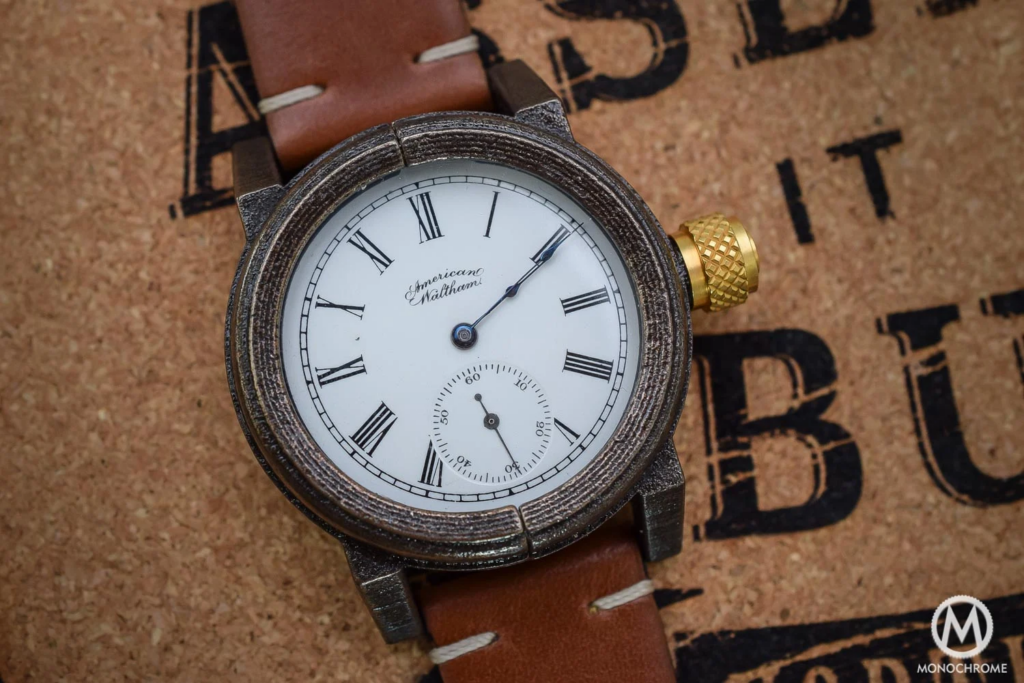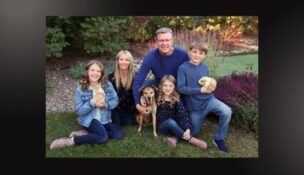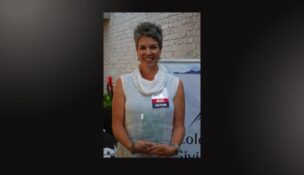Good Company — R.T. Custer & The Vortic Watch Company
In an exclusive interview with ColoradoBiz, R.T. Custer, co-founder of Vortic Watch Company, discusses the company's success in product placement for TV shows like "Jack Ryan" and "House of Cards."
Jamie Siebrase //April 10, 2023//


Good Company — R.T. Custer & The Vortic Watch Company
In an exclusive interview with ColoradoBiz, R.T. Custer, co-founder of Vortic Watch Company, discusses the company's success in product placement for TV shows like "Jack Ryan" and "House of Cards."
Jamie Siebrase //April 10, 2023//
Learn how R.T. Custer and Vortic Watch Company work with prop masters to place their watches on characters that fit the brand’s industrial style. He also shares how Vortic’s unique business model, which upcycles antique U.S. pocket watch mechanisms, allows the company to manufacture truly American-made watches. Additionally, Custer discusses the power of email marketing and how it has been Vortic’s most effective form of advertising.
R.T. Custer
Co-founder and CEO, Vortic Watch Company
Fort Collins
Hometown: Reading, Pennsylvania
What he’s reading: “Becoming an Empowered Projector: Thrive with Wisdom and Guidance from Human Design,” a recent book by Evelyn Levenson about human design. “I’m a projector of human design,” Custer notes, “And I’m trying to understand what that really means.”
ColoradoBiz: We understand John Krasinski will be wearing a Vortic watch in the fourth and final season of “Jack Ryan.” How’d you pull that off?
R.T. Custer: That’s right, we have a watch on Jim from “The Office” and also Michael Kelly. At Vortic, we focus one layer of marketing on product placement, and we’ve used that not only for advertising, but networking as well. Long story short, a friend of mine, Mark McFann, specializes in product placement, and he’s gotten us on a few famous wrists.
CB: We’ve got the time (no pun intended). Why don’t you give us the long story, too?
RTC: We work directly with prop masters for product placement. When there’s an opportunity for a big, American-industrial style watch, a prop master will contact us to see if Vortic would be a good fit for a particular character or show. Several years ago, when filming for “Jack Ryan” Season 3 was underway, the prop master reached out to us about our Military Edition watches.
The backstory is we make antique Air Force wristwatches from pocket watches that were flown on the B Bombers of WWII, to make sure navigators knew where they were in the sky. It’s the ultimate piece of American history. We release these watches annually on Veteran’s Day, and a portion of the proceeds goes to a nonprofit program, the Veterans Watchmaker Initiative, one of the only watchmaking schools in the country. Watchmaking is a skilled trade, and there aren’t currently enough people who know how to repair watches to meet the demand.
So originally, the “Jack Ryan” prop master wanted a watch for Michael Kelly, a co-star who’d played Doug Stamper in “House of Cards,” one of my favorite shows. We sent a watch, and he’s wearing a Vortic all through Season 3. Then we get another email from the prop master: John asked if he could have one, too. We make a new edition of the watch every year, so John Krasinski will be in our third edition when Season 4 comes out.
CB: What’s the lesson here for other manufacturers?
RTC: It’s the relationships and the partnerships that matter. We also have a watch on Kevin O’Leary, the billionaire from “Shark Tank.” The credibility in brand association that I get from that — it’s worth millions. And it didn’t cost me a cent; it was just the relationships I had to build along the way. People assume you have to spend a fortune on advertising when really, it’s that thing people always say and then forget: It’s not about what you know, but who you know
CB: So is product placement the best way to sell a tangible product?
RTC: It’s a niche style of marketing, and it’s a long game. We ship the watch to a show, they film, and then two years later the show comes out. I’m betting somebody will see the watch, then Google it. Hopefully they eventually make it to my website and buy one.
I run a watch company, but I’m a marketing guy. Both my parents were “Mad Men” in the ‘70s. They worked for huge campaigns for Pepsi and McDonald’s. What I know and love is marketing, and at Vortic we do it all – everything from Facebook ads to print advertising – but my most effective form of advertising is email marketing.
CB: That’s surprising in 2023, isn’t it?
RTC: Email marketing is the only clear path to revenue that I know works 100 percent of the time. Once you sign up for Vortic’s email list, I know you’re going to buy a watch, it’s just a matter of time.
CB: How, exactly, do you know that?
RTC: Have you seen our watches? People love what we do. Our primary product is the American Artisan Series. This is a one-of-a-kind line of wristwatches, each piece is unique, fabricated with antique U.S. pocket watch mechanisms. And they are the only truly American-made watches that are available today.
CB: You’re making orphaned, upcycled wristwatches, then. That is a unique concept. Where’d an idea like that come from?
RTC: My business partner Tyler Wolfe and I came up with the idea on the golf course at Penn State in 2010 when we were studying engineering. We had a bunch of ideas surrounding wristwatches, but we decided that if we started a watch company, we wanted to manufacture in America. This sent us down a major rabbit hole. Can you even make a watch in America?
CB: Well, can you?
RTC: When most people think of luxury watches, they think of Switzerland, and today, yes, it’s basically impossible to make the tiny gears and springs inside a watch in the U.S. But that wasn’t always the case. Little known fact: America used to be Switzerland. In 1900, if you asked anyone in the world where the best watches were made, it was Chicago or Boston. There were at least 10 great American watch companies along the railroads between Chicago and Boston, and they all made pocket watches. The wristwatch really didn’t appear until after WWII.
So, yes, you can make a watch in America if you upcycle pocket watches made here a hundred years ago. Tyler and I realized we could do this. We put that idea onto a Kickstarter in November 2014, shortly after we moved to Fort Collins. It was just me and Tyler, fresh out of college, and we crowd-funded the company. We now have our own manufacturing building, so people can schedule a tour on our website and come see how watches are made. We’re really the only place in America you can do that.
CB: Do upcycled watches sell?
RTC: We’ve sold almost every watch we’ve made. We put out roughly 300 to 350 watches a year. The company actually has three revenue streams. There are limited edition watches, including our Military and Railroad edition watches, which are all about historical storytelling. But the thing we’re most known for is our Watch of the Day.
We make one new watch every weekday, all year long, and release it at noon MST. It’s not an auction, just a set price, and once it is sold, that’s it. We’ve done this for a year now, and it was our pivot during COVID.
We used to do a lot of custom watches, but with so many unknowns in the world, people didn’t want to pay for a watch, then wait six months. We’ll still convert your grandfather’s pocket watch into a wristwatch: That’s our third service. It’s the simplest idea, but customers love it, and we’re the only company doing it. Google “Convert Your Watch.” We’re the first business to appear.
CB: Where do you find the pocket watches for your Limited Edition and Watch of the Day models?
RTC: Every day, somewhere in the U.S., a pawn shop or jewelry store goes out of business. For the past hundred years, these stores have been buying pocket watches and scrapping the gold, leaving the inside mechanism as trash. But a lot of these pawn and jewelry shop owners have hung onto the inside of the pocket watch because they feel bad about throwing a little, tiny engine away. I work with estate buyers who buy out pawn and jewelry stores, as well as watchmaker estates. I’m the only person who buys the mechanical part of the pocket watches. I’ll buy a hundred at a time then cherry pick the very best to turn into wristwatches. We’ve been around for eight years, and now I have sources who call me when pocket watches are available.
CB: Colorado has a reputation for being a haven for artisans, and Fort Collins in particular has become a major player in the buy-local movement. Has your physical location been an important aspect of business?
RTC: Yes, there’s a huge resurgence in manufacturing here, especially craft manufacturing. Stuff has been made in Colorado for hundreds of years, of course, but the craft industry and artisan style of small-batch, American made products — that’s Colorado. Think about it! Breweries, farm-to-table food — even distilleries are making small-batch blends. That’s what consumers appreciate here.
CB: Watch out — we’re about to throw a watch pun your way. What does a watchmaker do to unwind?
RTC: That’s a watch pun or a dad joke, depending on how you look at it. I’m a dad, so I love dad jokes. My wife and I have a cabin up north of Fort Collins where we like to get away with our family. We also love to travel to unwind. How’s that for a pun? One of the best things about living in Colorado is that I’m exactly an hour from the third-largest airport in the world. You can fly direct to almost anywhere you want. I’m a serial entrepreneur. Votic is my main thing, but I own other businesses, and I love entrepreneurship and talking about it. To be able to be an entrepreneur and not have anyone own my time – there’s another one – that’s why I love what I do.



























